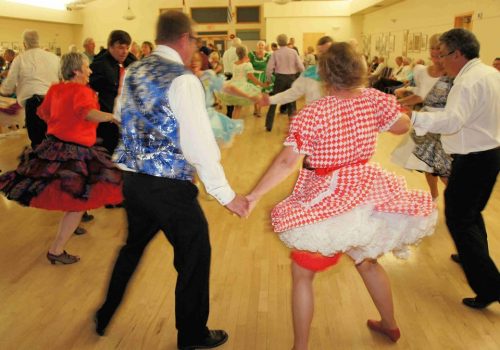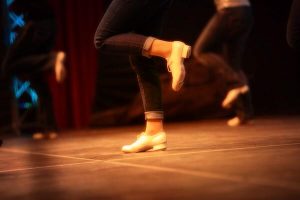What is Square Dancing?

Square dancing is a social activity where groups of eight people dance by interacting through a series of movements as “called” by the square dance caller. It is a healthy (both for mind and body), very social and fun activity. Square dancers often describe it as “friendship set to music.”
Square dancers learn the movements by joining a square dance club where the basics are taught. Once dancers have learned the calls, they can dance at any club or square dance event around the world. There are several levels of dance, including Beginners, Mainstream, Plus, Advanced and Challenge.
There are approximate seven thousand square dancers in British Columbia and XX square dance clubs.

Some Common Questions
No. It is a very reasonably priced and fun activity.
No. Square dancers welcome singles as well as couples.
You will love it. Exercise the body, stimulate the mind, and make new friends, it is easy and fun! If you would like to read articles and see videos about square dancing please click on the link below.
Modern square dancing incorporates all types of music. Everything from pop to traditional country to Broadway musical to contemporary country music—even rock, Motown, techno and hip-hop.
You will be having such a good time the short time it takes to learn will fly by.
No, people wear a variety of dress, from casual jeans and T-shirt, to “square dance attire,” to prairie skirts, and all styles of dressy and casual clothes. Although as one of our young members puts it, “I don’t have to wear square dance clothes, I get to!”
What is Round Dancing?
Round dancing is best described as choreographed ballroom dancing. It is a fun, social, non-competitive activity where all the dancers progress as couples counter-clockwise in large circles around the hall. Round dancing uses a cuer so that dancers don’t have to memorize a vast list of dance sequences. Dancers learn individual movements and then simply follow the cuers instructions. Each choreographed routine is set to a particular piece of music. The round dance has many choreographed sequences of steps that are borrowed from or can be transferred directly to normal ballroom dancing.
The aspiring round dancer gets started in the activity by joining a club that offers new dancer sessions. They receive instruction, workshop review and dance in a fun atmosphere that’s also a smoke and alcohol free environment. The dance season usually runs from September through to April. To learn even more, dancers can buy videos to supplement their formal instruction. Many square dance clubs incorporate round dancing into their programs because it is seen as a complementary dance form where couples can have a break from their squares to enjoy a few moments of dancing together.
There are six levels of accomplishment in round dance instruction, called phases. They progress from beginner through easy, intermediate and advanced. The music enjoyed in round dancing is mostly popular instrumentals and vocals from the easy listening category to golden oldies from the 1950’s. The tunes include Broadway show themes, swing, rock and western.

The easy level of round dancing emphasizes rhythms in 2-step and waltz. As one makes the transition to the intermediate level, the fox-trot, quickstep, tango, rhumba, cha cha and jive are introduced. Advanced levels add more rhythms and sophistication. In higher levels, the dancers might also find themselves doing the Macarena. As in any other activity, the dancers control how far they want to go.
Round dancing is a world-wide activity and English is the international language, although most clubs are in North America. An international association of round dance teachers, called ROUNDALAB, maintains the syllabus, instruction standards and the introduction of new steps and rhythms.
Articles and Videos On Round Dancing
Contra Dancing
Contra dance refers to a folk dance, similar to a Square Dance, except instead of the square formation, it is danced in lines of couples, with every other couple facing up or down the hall.
Clogging
Benefits Of Square Dancing
Fun For The Mind, Body And Soul
Discover a healthy activity that’s an enjoyable way to uplift your spirits and get more exercise. Meet friendly people in your neighbourhood while having loads of fun. Give square dancing a try!
Square dancing is an activity where groups of eight people dance by interacting through a series of movements as “called” by the square dance caller.
The movements are easy to learn at new dancer sessions that start with the basics. Once dancers have learned the calls, they can dance at any club or square dance event around the world.



